- Updated
- Technology
- Phones
Apple unveils its AI-enabled iPhone 16 with new camera controls, longer battery life
By Tim Biggs
Apple has revealed its lineup of iPhone 16 devices, which it said have been built from the ground up for generative AI features, alongside new watches and headphones at its annual event in California.
The new phones, along with the iPhone 15 Pro released last year, will work with a new set of features collectively dubbed Apple Intelligence to help users edit or re-draft messages, generate new emoji, and dig through all their on-device information to answer questions.
But while the new phones will arrive on September 20, Apple Intelligence will not launch until next month, and only for phones set to US English. Apple Intelligence in Australian English will arrive in December. Some features, like Image Playground and the newly redesigned Siri’s ability to see what’s on your screen or take action on your behalf in apps, will not launch until even further in the future.
At the event, Apple’s software engineering boss Craig Federighi went over the AI features unveiled earlier this year, emphasising that they’re private, secure and take advantage of all the personal data stored on your phone. They either work entirely on the device or make use of Apple’s own secure online servers powered by 100 per cent renewable energy. Some of the first Apple Intelligence features to roll out will be Writing Tools, which can edit and change the tone of your messages and the ability to transcribe and summarise recordings.
One new AI feature shown at the event was “visual intelligence”, which looks a lot like Google Lens. By pointing the camera at different objects, the phone will guess what information you need. Pointing at a flyer may offer to add an event to your calendar, while pointing at a dog will tell you the breed.
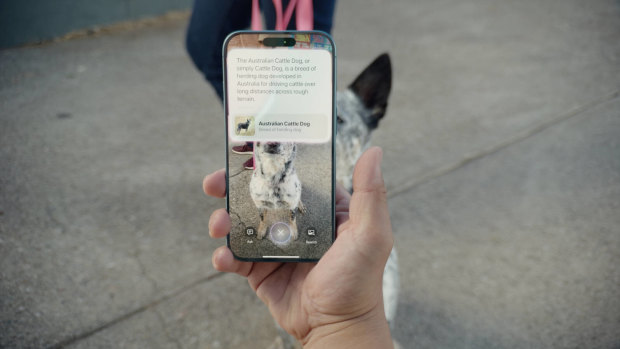
Apple Intelligence will include a camera mode that gives information about what your phone can see.
iPhones more powerful, (slightly) less expensive
The iPhone 16 (and the larger 16 Plus) is powered by a new A18 system-on-a-chip, which Apple said offers some significant improvements over the A16 used in last year’s standard phone – including 30 per cent faster CPU performance and 40 per cent faster graphics. The new chip also uses 30 per cent less power, which Apple said would result in much longer battery life, and the graphical power makes it compatible with games that previously only worked on the Pro phones.
The standard iPhone inherits a few more tricks from last year’s Pro as well, including the customisable action button, which will become more handy as iOS 18 enables it to toggle any task from a user’s Control Centre. There’s also macro photography on a new 12MP autofocus ultra-wide camera, and a 48MP main camera that can take 2x zoom shots without a loss in quality. The two lenses are stacked vertically this time (after previously being in a diagonal offset orientation), allowing them to record spatial photos and videos for viewing on the Apple Vision Pro headset.
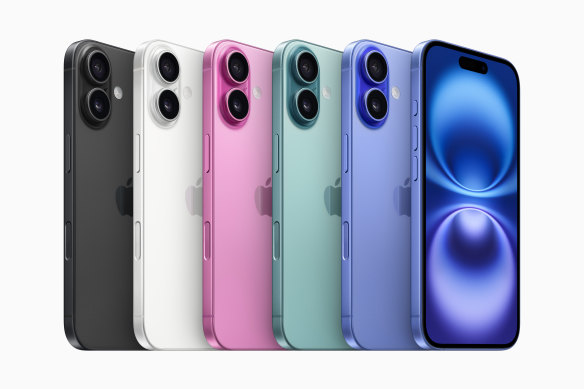
The iPhone 16 comes in bolder colours than last year, and has two additional buttons.
As well as the action button, the phone has a new touch-sensitive capture button for taking photos. You can press it any time to open the camera, then press it lightly for controls, firmly to capture or scroll on it to zoom or select options. The button sits flush with the phone so it’s unclear how difficult it will be to use with a case attached, but Apple said its own cases have a touch-sensitive area to translate your gestures.
The iPhone 16 and 16 Plus come in saturated pink, blue and teal colour options, as well as black and white, and unexpectedly will be slightly less expensive than last year’s models; starting at $1400 and $1600 respectively.
The iPhone 16 Pro and Pro Max add slightly larger displays, a 48MP ultra-wide camera, a third camera with 5x telephoto zoom, the more powerful A18 Pro chip and a raft of exclusive new recording features.
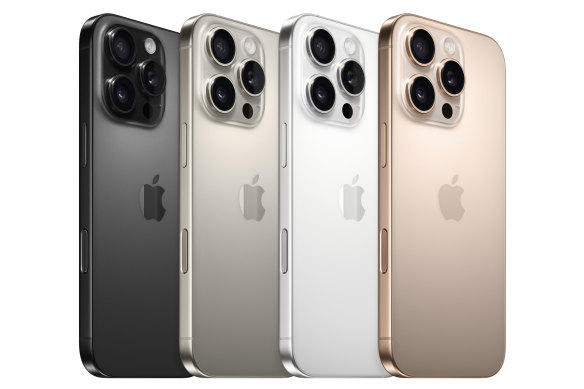
The iPhone 16 Pro has a slightly larger screen and a bigger battery.
For still photos, Apple said the Pro has new colour styles that you can now apply after you’ve taken the photo, and that in an update later this year, the capture button will get a two-stage shutter. For video, the phone supports capture of 4K 120 frames-per-second in Dolby Vision, so you can apply various slow-motion speeds in editing on-device. For audio, there are four microphones Apple said are “studio quality”, which enable a new Voice Memos feature that lets you record a track and listen to it back while recording a second track over the top.
Apple said the Pro phone would have the best battery life of any iPhone ever, with up to 33 hours of video playback on the larger model, and 27 on the smaller. They support faster 25W charging over MagSafe and Qi2.
The Pro iPhones come in black, white or natural titanium, plus a new desert titanium colour and will also be $50 less expensive than last year’s models; starting at $1800 and $2150.
Apple’s new watches and headphones
The Apple Watch has had its first major redesign in four years in the Series 10, with a larger display and thinner case that is also lighter than previous models. The watch comes in new 42mm and 46mm sizes, with aluminium or titanium cases. Apple said a new OLED screen makes the watch viewable from more angles, and able to refresh once per second in always-on mode (rather than once per minute), so you can see a second hand ticking without having to activate the screen.
The new watch introduces the ability to sense water depth and temperature, and comes with a Tides app to help plan aquatic activities. New features coming to WatchOS 11, which will also work on some older watches, include a new Vitals app to track health metrics, and the ability to define fitness goals according to days of the week, or to take a rest day. For the first time on an Apple Watch, the Series 10 can play audio from apps directly from its built-in speakers.
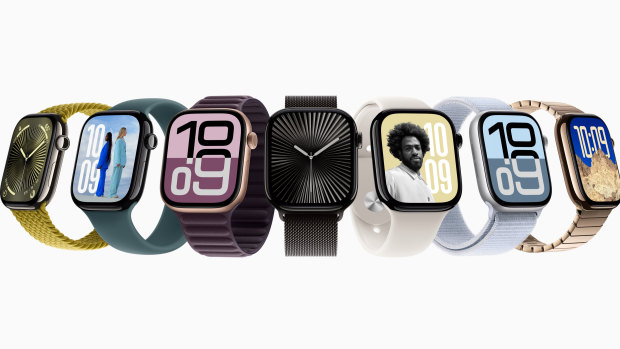
The tenth generation Apple Watch is thinner and lighter, but with a bigger screen.
The Series 10 will launch on September 20, starting at $650. Apple is also updating the Watch Ultra 2, originally released last year, with a new black colour option.
For headphones, Apple introduced a new line of AirPods that borrows some features from the more expensive AirPods Pro but maintains the traditional open-ear design. The AirPods 4 have a smaller case with USB-C charging, the same H2 chip as the Pros for spatial audio and low latency, plus a force sensor button for controls. They will sell for $220 starting September 20. Apple will also sell a $300 model that comes with a wireless charging case and active noise cancellation, though it said the $400 Pro model removes twice as much sound.
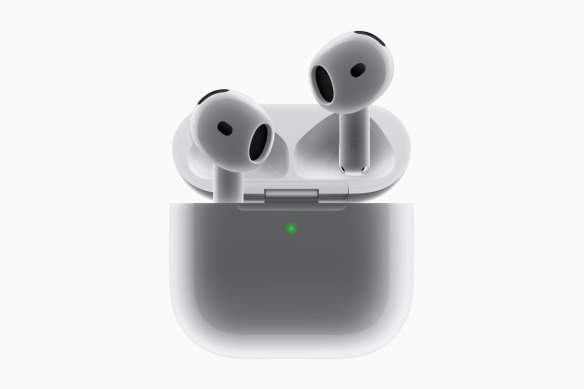
The AirPods 4 bring some features over from the Pro models.
During the presentation, Apple unveiled a new clinically-validated hearing test and said that the AirPods Pro would soon be able to function as medical grade hearing aids. It said the feature was still awaiting regulatory approval in the US but that it expects to roll out it out to more than 100 countries this year. It has not announced plans to bring it to Australia.
Finally, Apple made is rolling out a minor upgrade to the over-ear AirPods Max, with new colours and a USB-C port replacing the old Lightning connector.
Get news and reviews on technology, gadgets and gaming in our Technology newsletter every Friday. Sign up here.